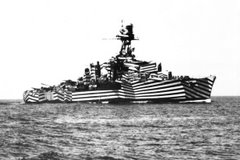Et cetera.
I will save the manifestos for the avant-garde, who comprise the subject of my first earnest post. Why "dazzleship?" The dazzle art movement -- there is evidence enough, it seems, to suggest that it was at least an aesthetic fad -- is something that I have foggily known about for a while and been occasionally piqued by for a good year. It is not yet something I have read any books about, so I have only enough authority to claim it as one of those interests that sits lightly on the most superficial layer of thought: rooted deeply enough to persist, but enjoying only rare flashes of intellectual sunlight. I intend for this to change, and for dazzle art to get promoted up the ranks of my fancies, but I am not willing to promise it to myself.
Dazzle art: one of those intensely curious moments in history where art and warfare join in true alliance. Not the kind of representational association between battle and battle painting, nor as between, say, armor and sheer decoration. The concept of modern camouflage, according to Timothy Lawrence Williams,
...was developed by a group of French artists serving in the First World War, who had the idea of using abstract painting techniques to conceal their battery from the enemy. This led to the formation of a Section de Camouflage in 1915. Nearly all the soldiers assigned to the section were artists; those of note include the cubist Jacques Villon, Jean-Louis Forain, Andre Dunoyer de Segonzac, Othon Friesz, Abel Truchet and Andre Mare founder of the Maison Cubiste. The French Section used the methods of the cubists to create deliberate distortions, forms that merge into other forms, planes or tones that bleed into other planes and tones and subtle use of colour and shading.Think of it! The application of fine art to aid warfare in an active and directly material way. A phenomenon, I suspect, made possible only by the unique conditions of the Great War (general belief in and fascination with technology, the nation-state, and the positive usefulness of combat) -- and rendered in later decades distasteful because of that same war. Dazzle art, creation of the British Vorticist Norman Wilkinson, aimed not to conceal but to confuse. Its geometrical patterns and unnatural color schemes, painted on the surface of naval vessels, were meant to disrupt the image of a ship as it appeared, most specifically, in the periscope of a U-Boat. The profile of the ship would be fractured by the pattern, making the vessel's heading less obvious and making it a much more difficult target for gunners and torpedoes. Its success was and is debated; but it certainly captured the imagination of its contemporaries -- and mine.





1 comment:
And then, in the tradition (the fine tradition, to all those haters) of English majors INTERPRETING when they should just be READING, I will provide a gloss: your blog will serve the same purpose of Dazzle Art, to confuse for martial purpose. Except it will be in the service of, well, the imagination of Andrew Behrent instead of any great nation state. And the dazzle, the confusion, will be part of the attack, will fully compose it. Like a zen koan, which if you try to think about it smart will make you feel stupid, and if you try to think about it stupid you'll end up feeling smart.
All this dissipation doesn't mean you don't have to post, of course.
Post a Comment